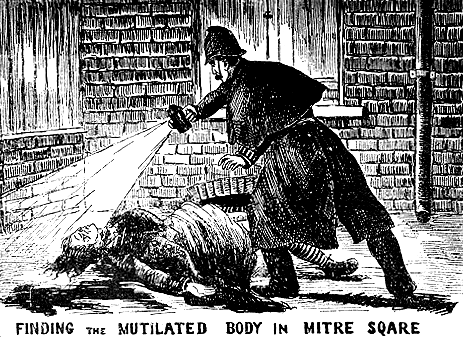Jack the Ripper Revisted (or not, as the case may be…)
/ Before we start into this week’s blog post, Ann and I wanted to give a little shout out to Kirkus Reviews who has once again reviewed our upcoming novel, saying of TWO PARTS BLOODY MURDER: “Leigh's fourth is a complex case loaded with forensic and historical detail, the authors' best so far.” For those who are interested in the full review (warning— which comes with some spoilers), you can find it here.
Before we start into this week’s blog post, Ann and I wanted to give a little shout out to Kirkus Reviews who has once again reviewed our upcoming novel, saying of TWO PARTS BLOODY MURDER: “Leigh's fourth is a complex case loaded with forensic and historical detail, the authors' best so far.” For those who are interested in the full review (warning— which comes with some spoilers), you can find it here.
Two months ago we covered the supposed revelation of the identification of Jack the Ripper more than 125 years after the Ripper’s final kill. It was a story that made a very big splash and was carried on almost every news outlet in the English-speaking world (and beyond). It also accompanied Russell Edwards’ book on the same topic, Naming Jack the Ripper. In our response to the story, we outlined all the reasons we were more than skeptical about the identification. However, we didn’t have access to the samples to be able to put data-driven science behind our opinion; we simply logicked through the information provided and were entirely unconvinced that Aaron Kosminski was the Ripper.
The original case naming Aaron Kosminski as the Ripper rested entirely on the discovery of a shawl that was posited to belong to Ripper victim Kate Eddows. According to Dr. Jari Louhelainen, the scientist working with Edwards, the shawl was matched to Karen Miller, a descendant of Kate Eddows, and thereby to Kate herself by showing an extremely rare genetic connection—a gene called 314.1c—in the mitochondrial DNA passed down through the female line of the Eddows family. Due to the scarcity of this gene in the general population, it was deemed that the shawl must have come from Eddows. The entire case rested on this one point.
Last month, in a story that barely made a ripple on the vast ocean of current media, it was announced that other scientists got access to Louhelainen's data, and science simply doesn’t support the Ripper identity claim. What was declared to be the rare gene 314.1C (occurring in only 1 in 290,000 people), was, in fact, the extremely common gene 315.1c (occurring in 99 out of 100 people of European decent). Four well-known and respected experts in the field of DNA analysis and fingerprinting all agree that there is no ground for a direct match between the modern family member and the scarf.
It has been stated that Dr. Louhelainen used an ‘error of nomenclature’ when doing his analysis and carried that error into announcing his findings. But the bottom line in this case is that nearly anyone could have left the DNA on the shawl that is attributed to the victim of Jack the Ripper. Without this crucial link, the rest of Edwards’ case for Aaron Kosminski falls apart.
With all the fuss and furor over the revelation that Jack the Ripper had been identified, it’s a shame that the news disproving this claim has hardly been noticed. For us, at least, this was no surprise considering the previous analysis. But for the majority of the world, I suspect they still believe that the Ripper case has been closed.
Photo credit: Wikimedia Commons
It’s giveaway time! TWO PARTS BLOODY MURDER will release in February of 2015 and we’ve got ARCs to give away months beforehand. Want a signed advanced reading copy of Matt and Leigh’s next exciting adventure? Sign up here: https://www.goodreads.com/giveaway/show/115336-two-parts-bloody-murder. The giveaway is open until 11:59pm on November 20th, so don’t miss out!



 93.4%
93.4% Planning
Planning